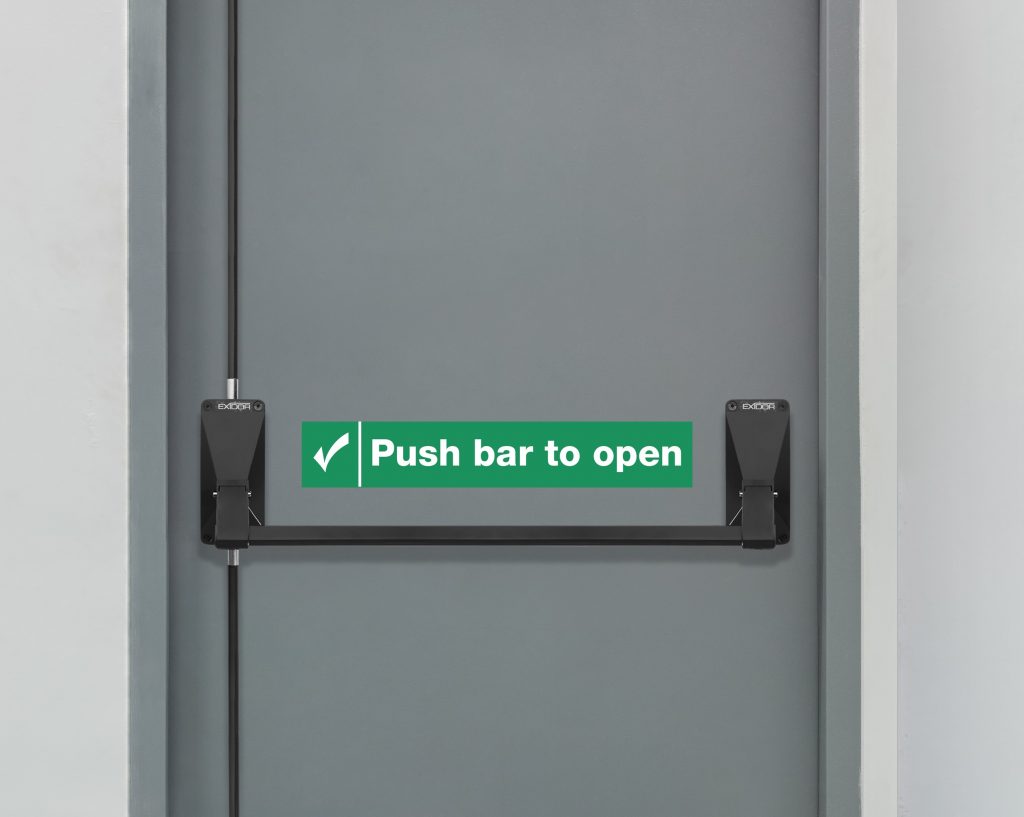Alison Aston, Lead Category Manager – Safety Products at ASSA ABLOY
When disaster strikes within a building, it is essential that exit hardware is fitted and correctly specified, so that occupants are able to leave as quickly and safely as possible. There are many types of exit hardware available, and the type you should install depends on several factors. It’s also essential to ensure that all exit hardware meets the relevant legislation.
Here’s a brief guide to the main things locksmiths should keep in mind when choosing exit hardware.
Panic hardware versus emergency hardware
There are two types of exit hardware – panic hardware and emergency hardware. Both are designed to enable building users to escape through doors that are otherwise locked from the outside to prevent entry into the building, but have different scopes of application.
Panic hardware is designed for use in buildings where those inside are less familiar with the exit route. It consists of a long metal bar that covers at least 60% of the door’s face and is activated by a simple push of the bar. The hardware can be a touch bar that lies flat against the door skin or a push bar that is suspended above the door face from 2 end units making it ideal for glazed doors. Pushing the bar retracts the locking points (such as latch or shootbolts) and opens the door, making it perfect for people trying to leave the building in a hurry. The bars are fitted on outward opening doors due to the push operation, but also to avoid being a hazard to the flow of traffic during evacuation.
Most commonly found in buildings where members of the public will be present, such as hotels, shopping centres, and event spaces, panic hardware must conform and be CE and/or UKCA marked to EN 1125.
Emergency hardware, on the other hand, is used in settings where those inside are aware of both the exit route and how the exit device works. Consisting of a smaller push pad or handle, emergency hardware is likely to be found in places such as factories, warehouses, and offices, where employees will be familiar with all the exit routes, how to operate the exit hardware and will have had the necessary training and inductions. All emergency hardware must conform and be CE and/or UKCA marked to EN 179. Emergency exit devices can be installed on outward opening doors; however, some models are suitable for use on inward opening doors as well.

Security
In addition to the British Standards governing panic hardware and emergency hardware, both can be included in PAS24 doorset testing and approval. This provides added peace of mind to the building owner and users; thanks to the burglary resistant abuse testing this involves.
For the more extreme end of security, there are also escape hardware products, that have been included in LPS 1175 doorset testing. This is multi-level testing offering different ratings against forced entry from low to extreme attack levels. Products tested to middle or higher end of these security ratings may be an ideal solution when used in environments of higher vulnerability.
Concealed exit devices for a coordinated finish
As well as meeting the relevant legislation, many end-users will want the hardware to complement the look and feel of the building. That’s where concealed solutions come in, fitting in with the design scheme while being visible enough to perform their primary function should an emergency happen.
Here at ASSA ABLOY, we’ve recently launched our concealed vertical rod range made up of a push bar, push pad, touch bar panic and outside access device accessories. Specifically designed for aluminium doors, it forms an integral part of building safety.
British-designed and manufactured to the highest standards, the range has been independently tested and certified to EN 1125 and EN 179 and successfully passed the rigours of PAS24 as a component of a tested doorset.
With the new range, no special keeps or mounting plates are required for use on the approved PAS24 doorsets, making it compliant out of the box and easier to order, carry on-site and install by the locksmith.
Our extensive family of panic and emergency hardware offering across our brands includes products that have been tested as part of a doorset to LPS 1175 levels 4 and 6. The Exidor 700 series can be the ideal solution for environments vulnerable to attack or on door that are protecting higher value assets.
There’s much to think about when selecting exit hardware. The first consideration should be whether the building needs panic hardware or emergency hardware. The second consideration might be security aspects for the doorset, with many commercial specifications looking for PAS24 testing, or sensitive sites demanding LPS approved solutions. Then, ensure the solutions meet all the relevant legislation on that particular door substrate, as only then will you be covered. Finally, consider a concealed or subtle solution that pulls its weight in terms of aesthetics as well as function.
To find out more about ASSA ABLOY’s new concealed vertical rod range, please visit www.assaabloy.com/uk/en/solutions/products/panic-and-emergency-exit-hardware
